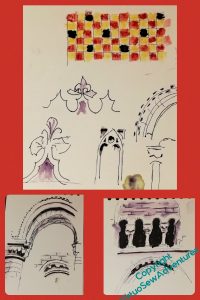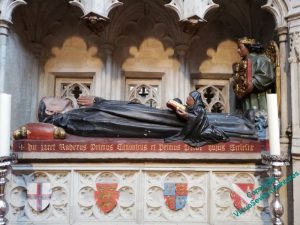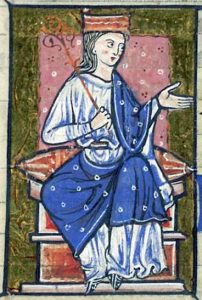Tag: Rahere
Research for Rahere
I had another chance to go to the Church of St Bartholomew The Great in Spitalfields recently, and managed to get in a solid couple of hours of sketching and thinking while I was about it. I did attract a bit of attention – someone came and asked whether they could take my photo as I sketched, and even photographed the sketch itself, but it was in the morning on a cold and wet Saturday, so there wasn’t too much activity. By the time the tour groups started to come in and obscure what I wanted to sketch, I was becoming chilled and clumsy and in need of food and a hot cup of tea.
I might use that coloured tile pattern in the border of Rahere’s panel, instead of a plain colour. I think I’d want to make the colours closer, to create the effect of a rich damask-type fabric, but I feel a bit wider variation is needed among the four panels. I want each of them to stand alone, but if they end up displayed together, they need to look happy…
I had been wondering whether it would be legitimate to include scallop shells in the borders, to reference pilgrimage, since most often I have heard of the scallop shell being associated with the Camino to Compostela. Plainly the makers of the pews thought so!
I’m still trying to work out what to set behind Rahere. Arches? A single arch, maybe, with the gold underside couching within. That may be a bit too reminiscent of a halo, and no-one, as far as I know, has ever even suggested Rahere as a candidate for sainthood. If Kipling’s version of him has any veracity (it’s certainly not based on research – you might call it a possible emotional truth), he’s very much in the category of people who make for an challenging example – speaking truth to power is not a gift we all have, although we may all agree that it is important that it happens.
In truth I think he’s more valuable as an example to follow without the accolade. He is credited with founding an institution which continues to provide healthcare, 900 years after foundation, he is still remembered, and no one suggests that what he did is the less valuable for the lack of a sainthood.
As you see – he is still remembered.
More on Mother Julian and Rahere
I have a steadily extending bookshelf of reference material. Not all useful, alas, but in this stage I never know what is useful until I get there, so I just have to keep reading.
I’m trying to plan the borders for my planned pieces – these are companions for William Marshall, after all, so the basic style of the designs needs to match his. So, for example, since Julian of Norwich and Rahere are both clerical figures, at least to a degree, maybe I can take into account the information that the “lilies of the field” mentioned in the Bible are probably Lilium candidum, which is native to the Holy Land. Perhaps I could include them, and scallop shells (emblems of pilgrimage), and maybe London Pride (scabious urbanum?) for Rahere? Or maybe lavender or one of the healing herbs? And for Julian, the lilies of the field with hazel leaves and nuts?
I’ve started also to think about the designs themselves. Among the references I’ve not shown in that picture, I have a book of Psalms illustrated with a variety of artwork from the medieval and renaissance period. The illustrations weren’t chosen with my needs in mind, of course, so this rather scrappy effort for Julian is based on a combination of several. I’d like to have a better drapery effect when I get there, although I have to be careful not to be too exaggerated – I can’t imagine anchoresses dressed in the height of fashion!
For Rahere, I can use the drawing of the effigy on his tomb as the basis, but in his hands will be a model of the Priory and Hospital of St Bartholomew The Great, and at his feet the jester’s cap symbolising the life he rejected after the loss of The White Ship. I may have building work behind him, the beginning of a tower or a wall.
When I made my first research visit to St Bartholomew’s, I didn’t look at the outside, which may prove to be a mistake. Fortunately I am sure I will get another chance to visit!
By contrast, when I visited Mother Julian’s Church, I didn’t do a sketch inside her cell – that would have involved being terribly in the way for the people preparing for a Flower Festival later in the week. I sat in the churchyard and painted the outside, instead. Norwich is a bit more of an epic to get to from the west coast, where we are, so I may have to be Even More Imaginative for Mother Julian’s surroundings!
Researching Rahere..
It’s going to be some while before I can start stitching on the other Medieval Movers and Shakers (I’m going to have to find a better title for that quartet, they’re going to drive me demented if I don’t!), but given I have much research to do, that’s no great difficulty.
I have been accumulating books – which is also rather a delight in any case.
The history of the church Rahere founded duly arrived a week or so after our visit, and proved very interesting indeed. It included among the illustrations this engraving of the tomb effigy on Rahere’s tomb. The tomb was not made for Rahere when he died, but about four hundred years later, so one should take the likeness of the face with a pinch of salt, but I’m sure it will have got his Dominican robes right, so it may be useful in planning how I depict him. (I’ve just double checked – white cassock and black cloak, so for the purposes of the embroidery I can go for the look of undyed wool for the cassock, and dark greys and browns for the cloak).
I also found a reference to an epic poem called The Romance of Rahere, thinking it might at least be atmospheric.
Well, no. It’s set in the Civil War, about the orphan daughter of the vicar of St Bartholomew the Great who is named after the founder (poor lass) and who dies in the church during a thunderstorm, leaving the boy who wants to marry her absolutely distraught, and becoming a soldier to seek death, but surviving and returning home to right the wrongs caused by his greedy and abusive father.
So not even remotely helpful!
In the Kipling tale in which he appears, “The Tree of Justice”, Rahere, the Kings’ Jester, is described as: “more of a priest than a fool and more of a wizard than either“, and his jester’s outfit as parti-coloured in black and red. There is so little information about the person that I’m going to be using that as the basis for my characterisation. My current idea for the embroidery design is to have Rahere in his Dominican Robes, with a model of St Bartholomew the Great in his hands, and his jester’s cap at his feet. The border – well, maybe the flower London Pride, maybe bells (for the jester) and scallop shells (for pilgrimage). We’ll just have to wait and see!
Researching Rahere
A journey through London gave me the opportunity to visit the Church of St Bartholomew The Great in Smithfield, which is indeed very close to the Hospital Rahere founded, known today as St Barts.
It, and Rahere himself, have had varying fortunes and visibility over the years, and, for example, Rahere’s tomb was built in the fifteenth century, nearly four centuries after his death.
I haven’t yet discovered whose shields are displayed there, but it seems likely I will. The Rector was involved in a wedding rehearsal when I arrived, but I carried on quietly sketching and walking around the Church, staying out of the way as best I could while still continuing to work.
And I had my reward in due course, when, on the principle that Bairns As Don’t Ask, Don’t Get, I tracked him down afterwards and asked what, if any, information they had on Rahere and the early days of his foundation.
I may have bewildered him slightly – I have the impression that’s not the first thing people usually say! – but he took it well, and informed me that as this year is the anniversary of the foundation, a substantial History has been produced. So when that arrives, I shall have more to say on the subject, I’m sure!
Medieval Movers and Shakers
While I was working on William, my Mam passed to me her copy of Current Archaelogy, which included an article about the church founded by Rahere, jester to Henry I, then pilgrim and monk, founder of of St Bartholomew’s Hospital. Now, Rahere is a major character in one of the tales in Kipling’s “Rewards and Fairies”, which as a child I loved, and suddenly I found myself with an idea for some companions for William Marshall.
William Marshall, 1st Earl of Pembroke, jouster, statesman, guardian of kings, re-issuer of Magna Carta, subject of the first biography in English not concerning royalty or sainthood.
Athelflaed, daugther of Wessex, Lady of the Mercians, war leader and peaceweaver, guardian of Athelstan, she refortified Chester, and refounded the Minster which became, in due course, Chester Cathedral.
Rahere, jester, minstrel, courtier, pilgrim and monk, founder of St Bartholomew’s Hospital, which exists to this day.
Dame Julian Of Norwich, anchoress, mystic, author of the the first book in English known to be written by a woman.
In all these cases, some vestige of their activities still echoes down the ages, and between them they cover both the political and religious life of medieval period. Their activities are scattered across the country, providing some excuse for some visits and much reading.
I wonder what images I could put in their borders?
I think this could be interesting!



















